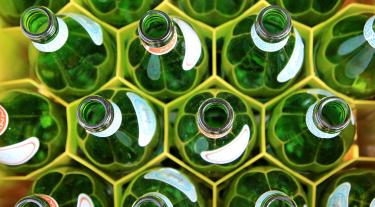Companies are always looking to provide more value to their customers and clients. As economies shift and decarbonise, these key stakeholders are looking for low carbon products and services. By addressing sustainability downstream in the value chain, it is becoming clear that businesses can not only save on efficiencies, but also capture market share.
When HSBC talks about its internal operations, its carbon reduction programmes – reducing waste, consuming less paper and water, and using more renewable energy – might not seem remarkable compared to those of other companies. After all, the bank’s offices have a tiny environmental footprint by comparison with some industries. But, when talking about its clients, the real scale of the bank’s opportunities quickly becomes apparent.
“Financial services has a fundamental role to play because we have the ability to direct financial flows,” says Daniel Klier, group head of strategy and global head of sustainable finance at HSBC. Provision of finance, he says, will be critical in meeting global carbon reduction targets. “We need the numbers – one often quoted is that it will take US$90-100 trillion of investment into sustainable infrastructure to deliver the Paris Agreement.”
To contribute to this, the bank in November made a commitment to put US$100 billion into the transition to a low carbon economy through a combination of its balance sheet, its asset management, through the bond market and by launching new financial products such as green loans and ESG loans.
It is also taking new models of sustainable finance into new territories. For the Indonesian government, for example, it has issued the world’s first green sukuk bond (the sukuk is the standard format for Islamic finance) and it is working with Chinese banks and other institutions that are going around the world to open markets in green panda bonds (RMB-denominated products from non-Chinese issuers sold in mainland China).
“Our ambition is to bring the green concept into new markets and establish standards that can be adopted by others,” says Klier. “The green market at the moment is very European and there’s good market development in domestic China. The question is how we can take that to other corners of the world – that’s one of the big roles we can play.”
Low carbon choices
If HSBC is spreading access to green finance to its clients, others are redesigning their products to help consumers make more sustainable choices. Microsoft, for example is working to design all its devices so that they have a minimal impact on the environment in their use of materials. For all its new products this year, the company has been able to take 20 per cent out of their weight.
Microsoft is also finding ways to make carbon emissions savings in packaging, shrinking the volumes of material used for its new product packaging by three per cent. “You might think that doesn’t have a lot of impact, because it’s just material,” says Joan Krajewski, general manager of safety, compliance and sustainability at Microsoft. “But year-over-year for all new programmes, the greenhouse gas associated with those programmes has decreased by 29 per cent, so taking what are seemingly small steps makes a really big difference.”
Of course, the challenge is what to do with products at the end of their lives. The problem is that being able to recycle products or reuse their materials relies on consumers returning them.
One solution is to extend the life of products, something Microsoft is doing by making it easy for consumers to fix products, rather than replace them. It offers a free service diagnostic tool to fix common software and settings issues, as well as repair programmes for devices both in warranty and out of warranty.
Meanwhile, Verizon has focused on building an efficient reverse logistics system, enabling it to maximise the number of devices, from mobile phones to routers, that it can recover and reuse or recycle. With RFID tags on more than 24 million devices and 7,000 of the vehicles in its fleet equipped with RFID technology, it can track the number and types of devices being collected and how fast they are recovered and returned into use.
“At any given time I can tell what’s in the technician’s truck down to the firmware and the serial number,” says James Gowen, head of its global supply chain operations and chief sustainability officer. “I can tell when it gets back to the depot, when it gets back to our staging location, where it goes through clean and screen. I have a target of 11 days from customer deactivation to getting it back in the forward logistics.”
This has enabled the company to put thousands of its devices back into use. For example, six out of 10 of its routers have been used at least once before. “Think about the cost avoidance and the reduced impact on the environment,” says Gowen.
Consumer education
As consumers become more interested in the environmental impact of the things they buy, some products can also be used to spread the message.
Danone’s flagship natural mineral water, evian will by 2020 become the first of the company’s brands to achieve carbon neutrality on a global basis. It has already achieved this status for all products sold in North America and communicates this to customers through the use of the Carbon Trust’s footprint label on its packaging. Danone also runs educational online campaigns with the media to help consumers better understand the importance of recycling in support of its ambition for all evian bottles to be made of 100% recycled plastic by 2025.
The company has made significant reductions in evian’s carbon footprint through transforming its bottling site in France, which is now powered entirely by renewable energy and has a private railway station to enable substantially lower carbon logistics. Remaining emissions are offset by carbon credits purchased through the Livelihoods funds. “This is an important signal about what we want to do as a business, because evian is one of our best-known brands,” says Eric Soubeiran, global nature and climate director at Danone. “The more brands you have like this, the more options you offer to the customer to vote for the world they want to live in.”
Read the full series
Part 1 - A time for corporate climate action
Part 2 - First steps in emissions reductions: energy efficiency in your own operations
Part 3 - Big benefits await those who tackle supply chain emissions
Part 4 - New climate opportunities are downstream
Part 5 - Power of the people: engaging your stakeholders on climate change



